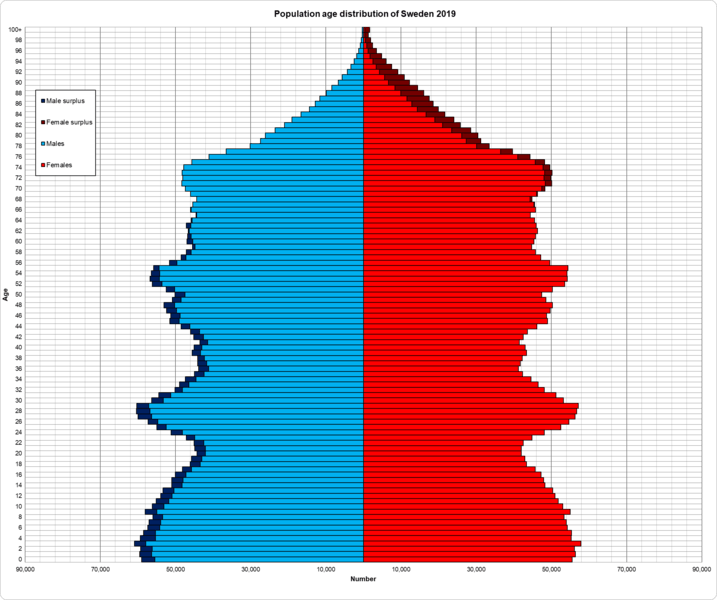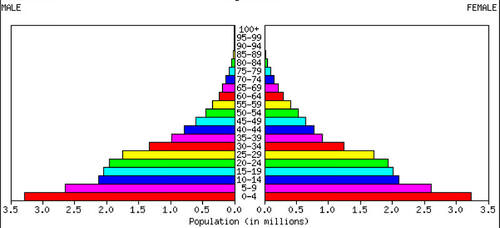6.23 近期和未来人口增长
Section outline
-
What you will learn
::你会学到什么-
Recent trends in human
growth
::人类增长的最近趋势 -
of human populations around the world
::全世界人口、人口、人口和 -
Future trends in human
::人类未来趋势 -
Impact of human population growth on the environment
::人口增长对环境的影响
Should the population of the planet be characterized by individual countries or as one general population?
::地球上的人口应该以个别国家或作为一个普通人口来描述吗?How many people is too many? Is there a limit? Is there a carrying capacity for humans? These are important questions that do not have an easy answer. But as our population continues to grow, these questions and others should be discussed.
::有多少人太多? 是否有限度? 人类是否有承载能力? 这些都是没有简单答案的重要问题。 但是,随着我们的人口继续增长,这些问题和其他问题应该讨论。Recent Population Growth
::最近的人口增长At one time, scientists predicted that all human populations would pass through the same demographic transition as Europe and North America. Now, they are not so sure. Death rates have fallen throughout the world. No country today remains in Stage 1 of the transition. However, birth rates are still high in many poor countries. These populations seem to be stuck in Stage 2. An example is the African country of Angola. Its population pyramid for 2020 is shown in the Figure . The wide base of the pyramid base reflects the high birth rate of this population.
::科学家们曾经预测,所有人类人口都会经历与欧洲和北美相同的人口结构转型。现在,他们并不那么肯定。死亡率在全世界已经下降。今天,没有一个国家仍然处于过渡阶段的第一阶段。然而,在许多贫穷国家,出生率仍然很高。这些人口似乎被困在第二阶段。安哥拉的非洲国家就是一个例子,其2020年人口金字塔在图中显示了。金字塔基底的宽广基础反映了人口出生率高。Angola’s population pyramid is typical of Stage 2 of the demographic transition. Many other countries have shifted to Stage 3 of the transition. Birth rates have started to fall. As a result, population growth is slowing. An example is Mexico. Its population pyramid for 2020 is shown in the Figure . It reflects a recent fall in the birth rate.
::许多其他国家已经转向过渡阶段的第三阶段,出生率开始下降,因此人口增长放缓,墨西哥就是一个例子,墨西哥2020年人口金字塔图示了2020年人口金字塔,反映了最近出生率的下降。Mexico’s 2020 population pyramid is typical of Stage 3 population. How can you tell that the birth rate has started to fall? Most developed nations have entered Stage 4. Sweden is an example (see Figure ). The birth rate has been low for many years in Sweden. Therefore, the rate of population growth is near zero.
::多数发达国家已进入第4阶段,瑞典就是一个例子(见图)。 瑞典的出生率多年来一直很低,因此人口增长率接近于零。Sweden’s 2019 population pyramid shows a population in Stage 4. In some countries, birth rates have fallen even lower than death rates. As result, their population growth rates are negative. In other words, the populations are shrinking in size. These populations have top-heavy population pyramids, like the one for Italy shown in the Figure . This is a new stage of the demographic transition, referred to as Stage 5. You might think that a negative growth rate would be a good thing. In fact, it may cause problems. For example, growth-dependent industries decline. Supporting the large aging population is also a burden for the shrinking younger population of workers.
::在一些国家,出生率比死亡率低得多,因此,他们的人口增长率是负的。换句话说,人口规模正在缩小。这些人口有头重脚轻的人口金字塔,如图所示的意大利。这是人口转型的一个新阶段,称为第5阶段。你可能会认为负增长率是件好事。事实上,这可能会造成问题。例如,依赖增长的产业下降。支持大量老龄化人口也是年轻工人人口减少的一个负担。This 2021 population pyramid for Italy represents a Stage 5 population. Future Population Growth
::未来人口增长During the month of October 2011, the world's population surpassed 7 billion people. It took just 12 years for the population to increase by a billion people. At this rate, there may be well over 9 billion people by 2050, and easily 10 billion people by 2100. This raises many questions for both people and the planet.
::2011年10月,世界人口超过70亿,人口仅12年就增加了10亿。 以这个速度计算,到2050年,人口可能超过90亿,到2100年,人口可能超过100亿。 这给人和地球都提出了许多问题。The human population is now growing by more than 200,000 people a day. The human population may well be close to its carrying capacity. It has already harmed the environment. An even larger human population may cause severe environmental problems. This could lead to outbreaks of disease, starvation, and global conflict. There are three potential solutions:
::人类目前每天增加20多万人,人口可能接近其承受能力,已经对环境造成危害。更多的人口可能造成严重的环境问题。这可能导致疾病、饥饿和全球冲突的爆发。有三种可能的解决办法:-
Use technology to make better use of resources to support more people.
::利用技术更好地利用资源支持更多的人。 -
Change behaviors to reduce human numbers and how much humans consume.
::改变行为 减少人类数量 减少人类消费 -
Distribute resources more fairly among all the world’s people.
::将资源更公平地分配给全世界人民。
Which solution would you choose?
::你会选择哪一种解决办法?Census Update: What the World Will Look like in 2050
::人口普查最新更新:2050年世界将是什么样子?According to the U.S. Census Bureau, in 2050, there will be 9.4 billion people:
::据美国人口普查局统计,2050年将有94亿人:-
India will be the most populous nation, surpassing China sometime around 2025.
::印度将是人口最多的国家,大约在2025年左右超过中国。 -
The U.S. will remain the third most populous nation, with a population of 423 million (up from 308 million in 2010).
::美国仍将是人口第三多的国家,人口为4.23亿(比2010年的3.08亿有所增加)。 -
Declining birth rates in Japan and Russia will cause them to fall from their current positions as the 9th and 10th most populous nations, respectively, to 16th and 17th.
::日本和俄罗斯的出生率下降,将使他们分别从人口最多的第9和第10个国家下降到第16和第17个国家。 -
Nigeria will have a population of 402 million, up from 166 million people.
::尼日利亚人口将达到4.02亿,比1.66亿人口有所增加。 -
Ethiopia's population will likely triple, from 91 million to 278 million, making the East African nation one of the top 10 most populous countries in the world.
::埃塞俄比亚的人口可能翻三番,从9 100万增加到2.78亿,使东非国家成为世界上人口最多的10个国家之一。
So what does all this mean?
::那么,这一切意味着什么?-
The African continent is expected to experience significant population growth in the coming decades, which could compound existing
food
supply problems in some African nations.
::预计非洲大陆在未来几十年将出现大幅度的人口增长,这可能会加剧一些非洲国家现有的粮食供应问题。 -
Immigration
and differing birth rates among races will change the ethnic composition of the U.S.
::移民和不同种族的出生率将改变美国的族裔组成。 -
Population booms in Africa and India, the decline of Russia, and the expected plateau of China will all change the makeup of the estimated 9.4 billion people who will call Earth home in 2050.
::非洲和印度的人口繁荣,俄罗斯的衰落,以及中国的预期高原,都将改变2050年将称为地球家园的大约94亿人的构成。
Summary
::摘要-
Other countries have completed similar demographic transitions. However, some countries seem stalled at early stages. They have high birth rates and rapidly growing populations.
::其他国家也完成了类似的人口结构转型,但一些国家在早期阶段似乎停滞不前,出生率高,人口迅速增长。 -
The total human population may have to stop growing eventually. Even if we reduce our use of resources and distribute them more fairly, at some point the carrying capacity will be reached.
::人口总数可能最终必须停止增长,即使我们减少对资源的使用并更公平地分配这些资源,在某一时刻将达到承受能力。
Review
::回顾1. Why was a fifth stage added to the demographic transition model? Describe a population at this stage.
::1. 为什么人口结构转型模式的第五阶段又增加第五个阶段?2. Which stage of the demographic transition is represented by the population pyramid in the Figure ? Why?
::2. 图中人口金字塔代表人口结构转型的哪个阶段?为什么?3. Evaluate how well the original demographic transition model represents human populations today.
::3. 评价最初的人口结构转型模式在当今人类中代表的程度。4. What is the human population problem? What are some potential solutions? Which solution do you think is best?
::4. 什么是人类人口问题?什么是潜在的解决办法?什么是最好的解决办法?什么是最好的解决办法? -
Recent trends in human
growth





